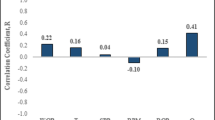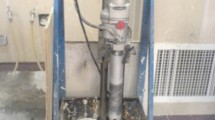Abstract
Unconfined compressive strength (UCS) is a major mechanical parameter of the rock which has an essential role in develo** geomechanical models. It can be estimated directly by lab testing of retrieved core samples or from well log data. These methods are very expensive and require huge efforts and time. Therefore, there is a need to develop a new technique for predicting UCS values in real-time. In this study, three artificial intelligence (AI) models were developed using artificial intelligence tools; artificial neural networks (ANN), adaptive neuro-fuzzy inference system (ANFIS), and support vector machine (SVM) to predict UCS of the downhole formations while drilling based on real-time recording of the drilling mechanical parameters. These parameters include rate of penetration (ROP), mud pum** rate (GPM), stand-pipe pressure (SPP), rotary speed in revolution per minute (RPM), torque (T), and weight on bit (WOB). A dataset of 1771 points from a Middle Eastern field was used to build the developed models: for training and testing processes. A new UCS correlation was developed based on the optimized AI model. Another set of data (2175 data points unseen by the model) was used to validate the model and the developed UCS correlation. The developed ANN-model outperformed the ANFIS- and SVM-models with a correlation coefficient (R-value) of 0.99 and an average absolute percentage error (AAPE) of 3.48% between the predicted and actual UCS values. The new UCS correlation outperformed the available correlations for UCS prediction and it was able to predict the UCS with AAPE of 4.2% compared to the actual UCS values.









Similar content being viewed by others
Abbreviations
- AAPE:
-
Average absolute percentage error
- AI:
-
Artificial Intelligence
- ANN:
-
Artificial neural network
- ANFIS:
-
Adaptive network-based fuzzy interference system
- SVM:
-
Support vector machine
- R:
-
Correlation coefficient
- R2 :
-
Coefficient of determination
- ROP:
-
Rate of penetration
- WOB:
-
Weight on bit
- RPM:
-
Rotating speed in revolution per minute
- GPM:
-
Gallon per minute
- SPP:
-
Standpipe pressure
- T:
-
Torque
- Fitnet Function:
-
Fitting neural network
- Newdtdnn:
-
Create distributed time delay neural network
- newnarx:
-
Create feedforward backpropagation network with feedback from output to input
- newelm:
-
Create Elman backpropagation network
- newfftd:
-
Create feedforward input-delay backpropagation network
- newff:
-
Create feedforward backpropagation network
- newlrn:
-
Layer-Recurrent Network
- tansig:
-
Hyperbolic tangent sigmoid transfer function
- logsig:
-
Log-sigmoid transfer function
- hardlims:
-
Hard-limit transfer function
- trainbr:
-
Bayesian regularization
- purelin:
-
Linear transfer function
- softmax:
-
Softmax transfer function
- tribas:
-
Triangular basis transfer function
- trainlm:
-
Levenberg–Marquardt backpropagation
- trainbfg:
-
BFGS quasi-Newton backpropagation
- traingdx:
-
Gradient descent with momentum and adaptive learning rule backpropagation
- trainoss:
-
One step secant backpropagation
References
Chau KT, Wong RHC (1996) Uniaxial compressive strength and point load strength of rocks. Int J Rock Mech Min Sci Geomech Abstracts 33(2):183–188. https://doi.org/10.1016/0148-9062(95)00056-9
Fjar E, Holt RM, Raaen AM, Horsrud P (2008) Petroleum related rock mechanics. Elsevier, Amsterdam
Shi X, Meng Y, Li G, Li J, Tao Z, Wei S (2015) Confined compressive strength model of rock for drilling optimization. Petroleum 1(1):40–45.
Liu H (2017) Rock mechanics. In: Principles and applications of well logging. Springer, Berlin, Heidelberg. pp. 237–269. https://doi.org/10.1007/978-3-662-54977-3
Abdulraheem A, Ahmed M, Vantala A, Parvez T (2009) Prediction of rock mechanical parameters for hydrocarbon reservoirs using different artificial intelligence techniques. In: SPE Saudi Arabia section technical symposium. Society of Petroleum Engineers., https://doi.org/10.2118/126094-MS
Militzer H, Stoll R (1973) Einige Beitrageder geophysics zur primadatenerfassung im Bergbau. Neue Bergbautechnik, pp 21–25
Golubev AA, Rabinovich G (1976) Resultaty primeneia appartury akusticeskogo karotasa dlja predeleina proconstych svoistv gornych porod na mestorosdeniaach tverdych isjopaemych. Prikl. Geofiz. Moskva 73:109–116
Chang C (2004) Empirical rock strength logging in boreholes penetrating sedimentary formations. J. Eng. Geol. 7(3):174–183
Mostofi M, Rahimzadeh H, Shahbazi K (2011) The development of a new sonic correlation for UCS estimation from drilling data. Pet Sci Technol 29(7):728–734. https://doi.org/10.1080/10916460903452025
Nabaei M, Shahbazi K (2012) A new approach for predrilling the unconfined rock compressive strength prediction. Pet Sci Technol 30(4):350–359. https://doi.org/10.1080/10916461003752546
Amani A, Shahbazi K (2013) Prediction of rock strength using drilling data and sonic logs. Int J Comput Appl 81(2):5–10. https://doi.org/10.5120/13982-1986
Asadi A (2017) Application of artificial neural networks in prediction of uniaxial compressive strength of rocks using well logs and drilling data. Proc Eng 191:279–286
Tariq Z, Abdulraheem A, Mahmoud M, Elkatatny S, Ali AZ, Al-Shehri D, Belayneh MW (2019) A new look into the prediction of static Young’s modulus and unconfined compressive strength of carbonate using artificial intelligence tools. Pet Geosci 25(4):389–399
Hassanvand M, Moradi S, Fattahi M, Zargar G, Kamari M (2018) Estimation of rock uniaxial compressive strength for an Iranian carbonate oil reservoir: Modeling vs artificial neural network application. Pet Res 3(4):336–345. https://doi.org/10.1016/j.ptlrs.2018.08.004
Amani A, Shahbazi K (2013) Prediction of rock strength using drilling data and sonic logs. Int J Comput Appl 81(2):7–10
Jackson CE, Heysse DR (1994) Improving formation evaluation by resolving differences between lwd and wireline log data. In: SPE annual technical conference and exhibition. Society of Petroleum Engineers
Dawson R (2011) How significant is a boxplot outlier? J Stat Educ 19
Zhou H, Deng Z, **a Y, Fu M (2016) A new sampling method in particle filter based on Pearson correlation coefficient. Neurocomputing 216:208–215. https://doi.org/10.1016/j.neucom.2016.07.036
Tariq Z, Elkatatny S, Mahmoud M, Ali AZ, Abdulraheem A (2017) A new technique to develop rock strength correlation using artificial intelligence tools. In SPE reservoir characterization and simulation conference and exhibition; Society of Petroleum Engineers: Calgary, AB, Canada. https://doi.org/10.2118/186062-MS
Elkatatny S, Tariq Z, Mahmoud M, Abdulraheem A, Mohamed I (2018) An integrated approach for estimating static Young’s modulus using artificial intelligence tools. Neural Comput Appl. https://doi.org/10.1007/s00521-018-3344-1
Gowida A, Moussa T, Elkatatny S, Ali A (2019) A hybrid artificial intelligence model to predict the elastic behavior of sandstone rocks. Sustainability 11(19):5283
Anifowose FA, Labadin J, Abdulraheem A (2017) Ensemble machine learning: An untapped modeling paradigm for petroleum reservoir characterization. J PetSci Eng 151:480–487. https://doi.org/10.3390/su11195283
Jamshidi E, Arabjamaloei R, Hashemi A, Ekramzadeh MA, Amani M (2013) Real-time Estimation of Elastic Properties of Formation Rocks Based on Drilling Data by Using an Artificial Neural Network. Energy Sources, Part A: Recovery, Utilization, and Environmental Effects 35(4):337–351
Zorlu K, Gokceoglu C, Ocakoglu F, Nefeslioglu HA, Acikalin SJEG (2008) Prediction of uniaxial compressive strength of sandstones using petrography-based models. Eng Geol 96(3–4):141–158
Cevik A, Sezer EA, Cabalar AF, Gokceoglu C (2011) Modeling of the uniaxial compressive strength of some clay-bearing rocks using neural network. Appl Soft Comput 11:2587–2594. https://doi.org/10.1016/j.asoc.2010.10.008
Lippman RP, Lippman RP (1987) An intrduction to computing with neural nets. In: Mag A (ed.) IEEE ASSP Magazine. IEEE. pp. 4–22, https://doi.org/10.1109/MASSP.1987.1165576
Hinton GE, Osindero S, Teh Y-W (2006) A Fast Learning Algorithm for Deep Belief Nets. Neural Comput 18:1527–1554. https://doi.org/10.1162/neco.2006.18.7.1527
Graves A, Liwicki M, Fernandez S, Bertolami R, Bunke H, Schmidhuber J (2009) A Novel Connectionist System for Unconstrained Handwriting Recognition. IEEE Trans Pattern Anal Mach Intell 31:855–868. https://doi.org/10.1109/TPAMI.2008.137
Nakamoto P (2017) Neural Networks and Deep Learning: Deep Learning Explained to Your Granny a Visual Introduction for Beginners Who Want to Make Their Own Deep Learning Neural Network (Machine Learning); CreateSpace Independent Publishing Platform: Scotts Valley. CA, USA
Jang JS, Sun CT (1995) Neuro-fuzzy modeling and control. Proc IEEE 83(3):378–406
Wang T, Ma M, Jianbin Q, Gao H (2020) Event-triggered adaptive fuzzy tracking control for pure-feedback stochastic nonlinear systems with multiple constraints. IEEE Trans Fuzzy Syst. https://doi.org/10.1109/TSMC.2020.3013744
Qiu J, Ma M, Wang T (2020) Event-triggered adaptive fuzzy fault-tolerant control for stochastic nonlinear systems via command filtering. IEEE Trans Syst Man Cybern Syst 2:1493–1499. https://doi.org/10.1109/FUZZY.1996.552396
Jang JS (1996) Input selection for ANFIS learning. In: Proceedings of IEEE 5th international fuzzy systems (Vol. 2, pp. 1493—1499). https://doi.org/10.1109/fuzzy.1996.552396
Aghli Ghasem, Moussavi-Harami Reza, Mortazavi Saiedollah, Mohammadian Roohangiz (2019) Evaluation of new method for estimation of fracture parameters using conventional petrophysical logs and ANFIS in the carbonate heterogeneous reservoirs. J Petrol Sci Eng 172:1092–1102
Gowida A, Elkatatny S, Al-Afnan S, Abdulraheem A (2020) New computational artificial intelligence models for generating synthetic formation bulk density logs while drilling. Sustainability 12(2):686. https://doi.org/10.3390/su12020686
Ja’fari A, Kadkhodaie-Ilkhchi A, Sharghi Y, Ghaedi M (2014) Integration of adaptive neuro-fuzzy inference system, neural networks and geostatistical methods for fracture density modeling. Oil & Gas Science and Technology-Revue d’IFP Energies nouvelles 69(7):1143–1154. https://doi.org/10.2516/ogst/2012055
Anifowose FA, Labadin J, Abdulraheem A (2013) Prediction of petroleum reservoir properties using different versions of adaptive neuro-fuzzy inference system hybrid models. Int. J. Comput. Inf. Syst. Ind. Manage. Appl 5:413–426
Vilela LRM, Oluyemi G, Petrovski A (2019) A fuzzy inference system applied to value of information assessment for oil and gas industry. Decision Making: Applications in Management and Engineering 2(2):1–18
Stojcic M, Stjepanovic A, Stjepanovic Djordje (2019) ANFIS model for the prediction of generated electricity of photovoltaic modules. Decision Making: Applications in Management and Engineering 2(1):35–48
Walia N, Singh H, Sharma A (2015) ANFIS: Adaptive neuro-fuzzy inference system-a survey. Int J Comput Appl 123(13):515–535
Xuegong Z (2000) Statistical learning theory and support vector machines. Acta Automatica Sinica 26(1):32–42
Xuegong Z (2000) Introduction to statistical learning theory and support vector machines. Acta Automatica Sinica 26(1):32–42
Gholami R, Shahraki AR, Jamali Paghaleh M (2012) Prediction of hydrocarbon reservoirs permeability using support vector machine. Math Probl Eng. https://doi.org/10.1155/2012/670723
Rostami H, Khaksar Manshad A (2014) A new support vector machine and artificial neural networks for prediction of stuck pipe in drilling of oil fields. J Energy Technol 136(2):67. https://doi.org/10.1115/1.4026917
Zhong YH, Li R (2009) Application of principal component analysis and least square support vector machine to lithology identification. Well Logging Technol 33(5):425–429
Funding
This research received no external funding.
Author information
Authors and Affiliations
Corresponding author
Ethics declarations
Conflict of interest
The author declares no conflict of interest.
Additional information
Publisher's Note
Springer Nature remains neutral with regard to jurisdictional claims in published maps and institutional affiliations.
Rights and permissions
About this article
Cite this article
Gowida, A., Elkatatny, S. & Gamal, H. Unconfined compressive strength (UCS) prediction in real-time while drilling using artificial intelligence tools. Neural Comput & Applic 33, 8043–8054 (2021). https://doi.org/10.1007/s00521-020-05546-7
Received:
Accepted:
Published:
Issue Date:
DOI: https://doi.org/10.1007/s00521-020-05546-7




